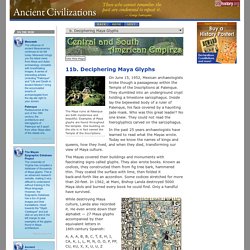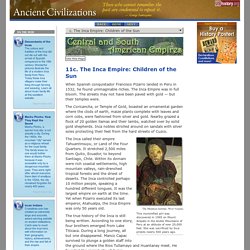

Mayan Facts - DK Find Out! Mayan cities › Mayan cities were stretched out across a large area now occupied by southeastern Mexico, Belize, Guatemala, and Honduras.

Each city had its own ruler. Mayan cities › Mayan arts and crafts › History hunters: Maya. Ancient Maya 101 - National Geographic. Ancient civilisations for children: Ancient Maya. The Ancient Mayan Civilization. Blood of Kings: The World of the Maya. Courtesy of Justin Kerr Maya ballplayers were often depicted in the artwork of vases.

One day in the final century B.C.E., the people of Cerros made a momentous decision. Cerros was a tiny settlement at the edge of Chetumal Bay in what is now Belize. Deciphering Maya Glyphs. The Maya ruins at Palenque are both mysterious and beautiful.

Examples of Maya glyphs are found throughout the temples. One building on the site is in fact named the Temple of the Inscriptions. On June 15, 1952, Mexican archaeologists broke though a passageway within the Temple of the Inscriptions at Palenque. They stumbled into an underground crypt holding a limestone sarcophagus. Inside lay the bejeweled body of a ruler of Palenque, his face covered by a haunting jade mask. Maya 3D. Incas - DK Find Out! Machu Picchu › Machu Picchu was an important fortress city in the Inca Empire. It escaped the notice of the Spanish conquerors and was not discovered until 1911. Machu Picchu › The Inca Empire: Children of the Sun. When Spanish conquistador Francisco Pizarro landed in Peru in 1532, he found unimaginable riches.

The Inca Empire was in full bloom. The streets may not have been paved with gold — but their temples were. The Coricancha, or Temple of Gold, boasted an ornamental garden where the clods of earth, maize plants complete with leaves and corn cobs, were fashioned from silver and gold. Nearby grazed a flock of 20 golden llamas and their lambs, watched over by solid gold shepherds. Ancient civilisations for children: Ancient Inca. The time compass: The Inca Empire part 1. The time compass: The Inca Empire part 2. The Inka Empire. The National Museum of the American Indian (NMAI) expresses gratitude to the people of Ecuador, Colombia, Peru, Bolivia, Chile, and Argentina, whose historical and cultural connections to the Inka Empire are represented on these pages.

The museum wants to thank the following staff and other contributors for their work in the creation of these lessons: Museum Director: Kevin Gover (Pawnee) The rise and fall of the Inca empire - TedEd. Machu Picchu: The Lost City of the Inca (click and drag to see 360 degrees) Aztec Facts - DK Find Out! Aztec beliefs › The Aztecs believed in many gods, but mainly worshipped the sun god.

They performed human sacrifices in order to keep the gods happy. History hunters: Aztecs. The Aztec World. A kingdom of blood.

SEP, Department of Education. The capital city of the Aztecs, Tenochtitlán, was an engineering masterpiece. The time compass: The Aztec Empire part 1. The time compass: The Aztec Empire part 2. The Aztecs. Tenochtitlan. Teotihuacan, Mexico. 50 kilometers northeast of Mexico City lies Teotihuacan (Teotihuacán), the ancient empire-city that used to be very large in size and then decayed over time.

Today the ruins are restored for the tourists. People have inhabited this territory, which had primarily been an agricultural area, since the 2nd millennium B. C. Modern scientists were unable to establish an exact date of when Teotihuacan was constructed. However, it is known that the mass migration of people from Cuicuilco, another city located in the Valley of Mexico destroyed by a volcano eruption, to Teotihuacan took place in the 2nd century A.